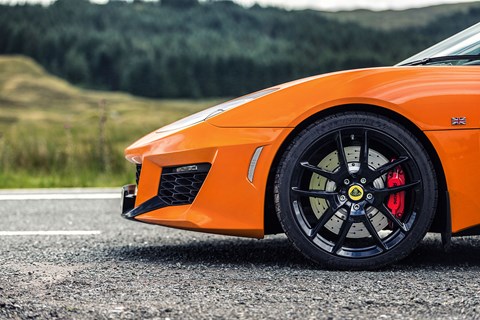► Lotus Evora 400 vs Aston’s brutal V12
► Two new British sports cars slug it out
► 21 and 22 in our #BritCarBucketList
Sheep stand by the roadside, stoic and oblivious to the raging din of a 592bhp Aston Martin Vantage GT12 tearing the atmosphere limb from limb with its titanium exhausts. Right behind it, chiming in with a backing track of equal ferocity whenever the knots of corners untangle into straights, a searing orange Lotus Evora 400 is giving chase across a forbidding, slate-skied landscape. The two make quite a spectacle. They’re proof too that, whether you want a jungle-ready 4×4, a track car to set your trousers on fire or an extrovert sports car to spike your pulse, Britain makes them all, and in some style.
Britain’s sports cars
This is not a comparison test, let’s be clear. Being a V12, of course, the Aston has twice the cylinder count, 50% more power and would come in at over three times the price of the Lotus, if you could still buy one. Just 100 GT12s will be built (a stiffly worded fax from Stuttgart put an end to this car’s early name, GT3), and all were accounted for before the car was officially announced back in February. The Evora 400 is Lotus’s brand new production model, two-thirds revised over its preceding namesake.
Rather, this is a celebration – of two exceptional new machines from two resurgent British sports car makers. Under Andy Palmer’s leadership, Aston is moving towards a bright future with new engine and electronics supplier Mercedes-AMG, meaning the GT12, with its naturally aspirated 6.0-litre V12, might just come to stand as the ultimate expression of Aston Martin as it is right now. Meanwhile Lotus CEO Jean-Marc Gales is busy repairing the damage done by the Bahar years of madness, returning the firm to an emphasis on adding lightness and setting the dynamic benchmark. The Evora 400 must deliver proof of this concept, especially when it’s priced from an eye-watering £72,000. You can buy an awful lot of Porsche for that.
Let’s start with the Aston. Decked out in the full Q-division painted launch livery of white, orange, silver and carbon – lots of carbon – the GT12 is all jutting aero, bulging arches and unabashed visual aggression. Given the regular Vantage V12’s hot-rod reputation, the GT12’s lines scream ‘approach with caution’. Fortunately the Aston’s wearing road-biased Michelin Pilot Super Sport tyres on those
New Lotus is added lightness and setting the dynamic benchmark – the Evora must deliver forged 19-inch rims, not some kind of cut-slick track rubber. The enormous Brembo carbon-ceramic brakes are comforting too, looking fit to stop a runaway A380.

The distended bodywork is all carbonfibre – bare weave visible on the underside of bonnet and boot lid – covering a wider front and rear track. Lithium ion battery, magnesium inlet manifolds and a magnesium torque tube contribute to total weight savings of 100kg; polycarbonate rear windows are optional – on an Aston Martin. The low-slung three-stage adaptive suspension retains a remarkable degree of civility, but with no way to raise the nose you can count on getting a fat lip from the occasional speed bump. This is a car for the committed enthusiast. The rear wing alone makes that much clear.
Pop the handle and step back – the rising door’s swan mechanism swings open fast enough to bop you on the jaw: not only is the outer door skin wrought from carbonfibre, the inner door card is carbon, too. You pull the lightweight combo shut with a tug on a folded leather strap rather than anything as humdrum as a conventional handle. Fixed-back racing seats tilt as one on an electric pivot to achieve some degree of comfortable accommodation. There’s more carbon lushness for the centre console; the rest of the cabin is black leather, black alcantara, classy buttons and chrome, punctuated by tiny highlights of orange to match the exterior detailing. The thin slivers of orange leather on the magnesium paddleshifters are a particular highlight, so delicate to the touch. In part and in whole, the GT12’s interior is utterly gorgeous, every bit the cool quarter-mil cockpit – until you activate the sat-nav, which has mapping graphics by Microsoft Paint.
Watch the rear-view mirror as you push the glass-topped totem that serves as a key into the dash – if you’re lucky you’ll see some poor soul duck and cover. A GT12 on start-up sounds as much like an explosion in a fuel depot as I ever want to experience: crump-whoomph-BOOM. Yank the fly-off handbrake between the seat and the door, pull the right-hand shift paddle and move gingerly away. Keep the Sport button disengaged if you want to do this with any degree of subtlety; this holds the exhaust valve shut until you properly nail it. Together with the unexpected ride compliance, this facility gives the GT12 the kind of long-distance refinement that’d make driving to Spa for a track day an enticing possibility rather than a migraine in embryo. You’re almost inclined to relax. Whatever you do, don’t.
On the road
First warning comes when the exhaust valve flips open on part-throttle, releasing a violent thunderstorm of snarling, angry clamour for not that much momentum. Plunge the pedal to the end of its travel and the GT12 shrieks and launches itself at the horizon. First time out you’re not sure what’s more intimidating; the rate of acceleration or the noise that comes with it.
The entire GT12 experience is dominated by the engine; its voice, its drive, its sheer drama. Immense traction and the awesome adaptive damping – which only gets better at checking surface imperfections in Sport – means the V12’s might remains exploitable when all around is damp, its output devouring straights and hurling the car out of bends. But even the wider track and superbly weighted steering’s super-sharp turn-in can’t disguise the sheer mass of exquisite metal in the Aston’s nose. In tight corners on narrow roads you brake, turn, feel the GT12 dart into the initial direction-change, then wait a heartbeat for the front to load up. Only then do you pivot into the turn. With a cliff face on one side and sheer drop on the other, slow-in, fast-out feels appropriate – though slow isn’t really that slow, and fast is much, much more than that. Immediately, and despite that very calm chat you had with yourself over breakfast this morning, you’re headlong into a no-holds-barred contest between your commitment and your nerve.
As your confidence builds, a couple of niggles blossom into bigger issues. The instrument cluster looks fantastic, in that typically Aston, expensive watch-face fashion, but there’s no redline marked on the back-to-front rev counter. This wouldn’t be so much of a problem if the GT12 wasn’t also lumbered with Aston’s slow-witted robotised manual transmission, which tends to stumble at the limiter. You can try lifting the throttle to make it shift quicker and smoother, but you’d best get the timing right or risk causing a calamitous weight transfer. Fortunately the brakes sizzle with feel and power, so you dive deeper into the corners, gradually finding a rhythm despite the faintly absurd pace. Alert to every surface change – standing water, bumps and cambers – concentration is total, and you sense that with more miles and seat time you’d be able to go even harder still. Time to ease off and swap cars.

Turning the Evora into the 400 included narrowing the extruded aluminium sills, immediately making it as easy to get into as any other car – black-belt yoga skills no longer required. You sit higher than in the Aston, and much further forward, to the extent that the 400 feels oddly like a hatchback. Perhaps subconsciously influenced by the orange wings curving away in front, the interior design reminds me of a McLaren; all is tastefully finished in blacks, greys and dark chromes. The centre stack features a much improved climate control interface, while wing-shaped peripheral displays flank the twin-dial instrument cluster. You can still stuff a couple of kids in the back, but our car has the no-cost +2 seating delete.
Good enough inside for £72k?
Well, it certainly feels very purposeful and bespoke. Moving the supplementary control buttons to the top of the dash has made a significant difference to immediate usability, and there are zero creaks and rattles – an area Lotus has worked especially hard on. But the Alpine infotainment unit will always look aftermarket, and the rear-view mirror is incredibly cheap to the touch – the price you sometimes pay for lightweight. Lotus has shorn a full 42kg from the Evora while adding bigger AP Racing brakes and a charge-cooling system that helps make the 3.5-litre supercharged V6 55bhp more powerful. Net result is 400bhp propelling 1395kg and, together with the chassis improvements, an Evora that is seven seconds faster around the Hethel test track than it used to be. That again: seven seconds. This gives you some idea of how, despite the Aston’s power advantage, the orange Lotus is almost always glued to the GT12’s back bumper. To drive the Evora 400 is to experience the kind of handling clarity of which dreams are made.
The Evora now starts on a button. As with the Aston there’s a moment of rev-flare drama, which promptly raises an eyebrow – since when did Toyota’s V6 ever sound this good? But the engine quickly drops back to a murmuring idle and you move on to fondling the spherical alloy gearknob. First gear slots home with a mechanical satisfaction, you release the handbrake, and then your foot nearly slips off the clutch pedal – damp soles and the apparently friction-free surfacing on the Evora’s alloy pedals don’t mix. An odd oversight. Adjusted for this, you’re finally good to go.

Oh my. It’s like being plugged back into the Matrix after taking the red pill – an extraordinary sense that suddenly, limits have been lifted and anything is possible. The uprated springs and conventional dampers fidget a little at lower speeds, but as you accelerate this fades in favour of your own personal geological survey of the road surface, filtered through a forged magnesium steering wheel that shimmies irresistibly in your hands like the hips of a samba dancer. Yet the 400 never gets deflected off line – within a mile claims of reduced bump-steer are emphatically affirmed. Today’s precipitation becomes almost irrelevant, as the same Michelin Pilot Super Sport tyres that help the Aston maintain its composure key the Evora right into the tarmac.
The steering is sensational, Lotus choosing that expensive mag wheel because conventional materials damped the silky, hydraulically assisted feedback too much. And there’s none of the lurking mid-engined weight transfer that forever adds an element of doubt to the Exige, just beautiful fluidity from corner entry to corner exit, which the standard limited-slip diff and increasingly slide-friendly Sport and Race ESP settings allow you to complete each bend with a flourish. But you sort of expect this from Lotus – it’s the 400’s newfound performance that really strikes you.
The Evora 400 is incredibly rapid, the supercharged six so immediate, so urbane, and so dialled into the rest of the car’s responses it feels like a tailormade unit. Given the attention lavished upon it in Norfolk, it pretty much is. The Aston is ultimately faster but you’ve got to be pretty damn committed to eke out anything resembling a gap on these roads. The Lotus acquires speed effortlessly, the noise it makes as it does so an addictive and irrepressibly exotic deep-throated sonic bark. Again, you can opt to keep the loud valve shut in the new exhaust and enjoy brilliant refinement; in fact, the Lotus is fun driven hard this way, since you get this sudden surge of volume as the redline approaches, like a jet fighter going to afterburners. Cue the next upshift.
Downshifts aren’t quite that straightforward, for in addition to being slippery, the pedals’ positioning proves tricky when you’re trying to heel-and-toe. The brake is exactly on the centreline of the steering wheel – great if you’re confident enough to left-foot it in a manual – but bridging to it from the low-hanging accelerator takes plenty of ankle articulation and practice. Think of this as part of the bonding process; ditto the gearlever action, which doesn’t like being rushed. There is an automatic alternative, if you’re worried. Or, with 302lb ft at 3500-6500rpm, you could just use third gear for the day. Or even fourth.
Two days of playtime, two very different cars, equally engaging in their own way. The GT12 is an animal, impressively domesticated in many respects, but you’ll ignore its wilder tendencies at your peril – there’s an element of danger that’s intrinsic to the car’s raw appeal. Yet it’s also impossible to overlook the nagging sensation that, with a decent gearbox, a great car could be made genuinely legendary. The Evora 400 stuns with its speed and scintillates with its chassis, as a modern Lotus should. Whether the interior is good enough to trouble the very slick competition remains debatable, but if driving is your priority you should start here. What seems expensive for a low volume, British-built coupe is cheap for a machine that now feels closer to a junior supercar. Is that sunshine I see ahead?
Aston Martin Vantage GT12
Price: £250,000 (£273,050 as tested)
Engine: 5935cc 48v V12, 592bhp @ 7000rpm, 461lb ft @ 5500rpm
Transmission: Seven-speed Sportshift III automated manual with paddleshifters, rear-wheel drive with limited-slip differential
Suspension: Double wishbones with adaptive damping
Performance: 3.7sec 0-62mph, 185mph, 19.8mpg, 332g/km CO2
Weight: 1565kg
Rating: *****
Lotus Evora 400
Price: £72,000 (£79,200 as tested)
Engine: 3456cc 24v supercharged petrol V6 with charge cooler, 400bhp @ 7000rpm, 302lb ft @ 3500-6500rpm
Transmission: Six-speed manual, rear-wheel drive with limited-slip differential
Suspension: Double wishbones all round
Performance: 4.2sec 0-62mph, 186mph, 29.4mpg, 225g/km CO2 (est)
Weight: 1395kg
Rating: *****
Jean-Marc Gales’s 5 must-drive Brits

Lotus Elite
‘Small, aerodynamic, lightweight, agile and pure, the Elite is one of the most beautiful cars of all time. It was not only a technological masterpiece using a lightweight composite monocoque structure, it was also a race winner including class wins at Le Mans.’
Lotus Excel
‘The Excel was way ahead of its time in terms of safety, performance and packaging. Perfectly balanced and a great design, it consistently beat the best that Germany could offer. It is becoming very desirable with classic values shooting up – now is the time to get one!’
Land Rover Series I
‘A very focused vehicle designed with one aim in mind. Lightweight, simple, easy to maintain, it is a fine piece of engineering that has endured for nearly 70 years. A proper right-first-time concept.’

Morgan Plus 8
‘Morgan deserves respect, with its craftsman-built ash frame, lightweight aluminium body and a design concept that has barely changed since the 1930s.’
Jensen FF
‘First production car with ABS and road specific four-wheel drive. Although it was not a commercial success, no-one can deny its contribution to the car industry today.’